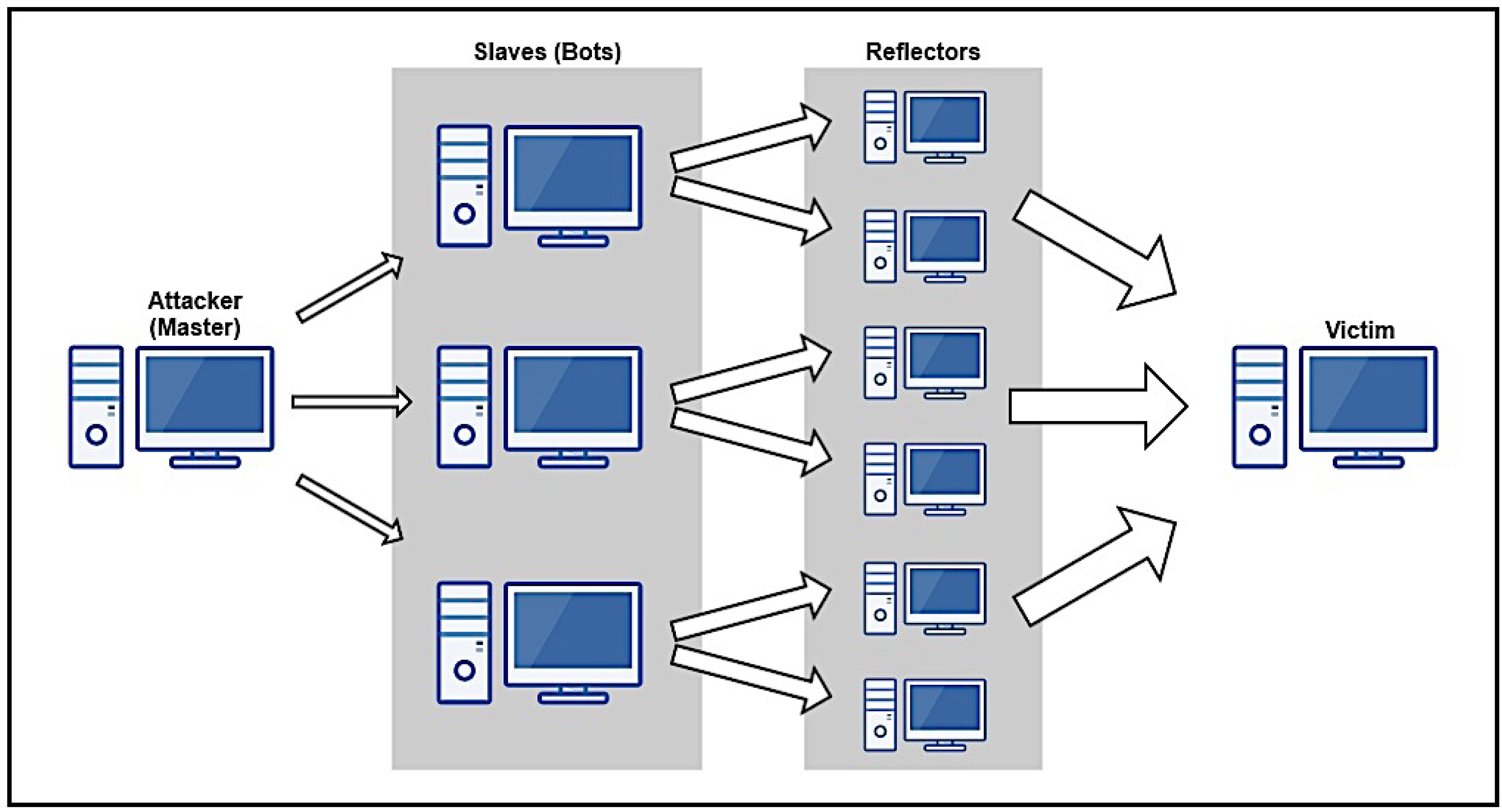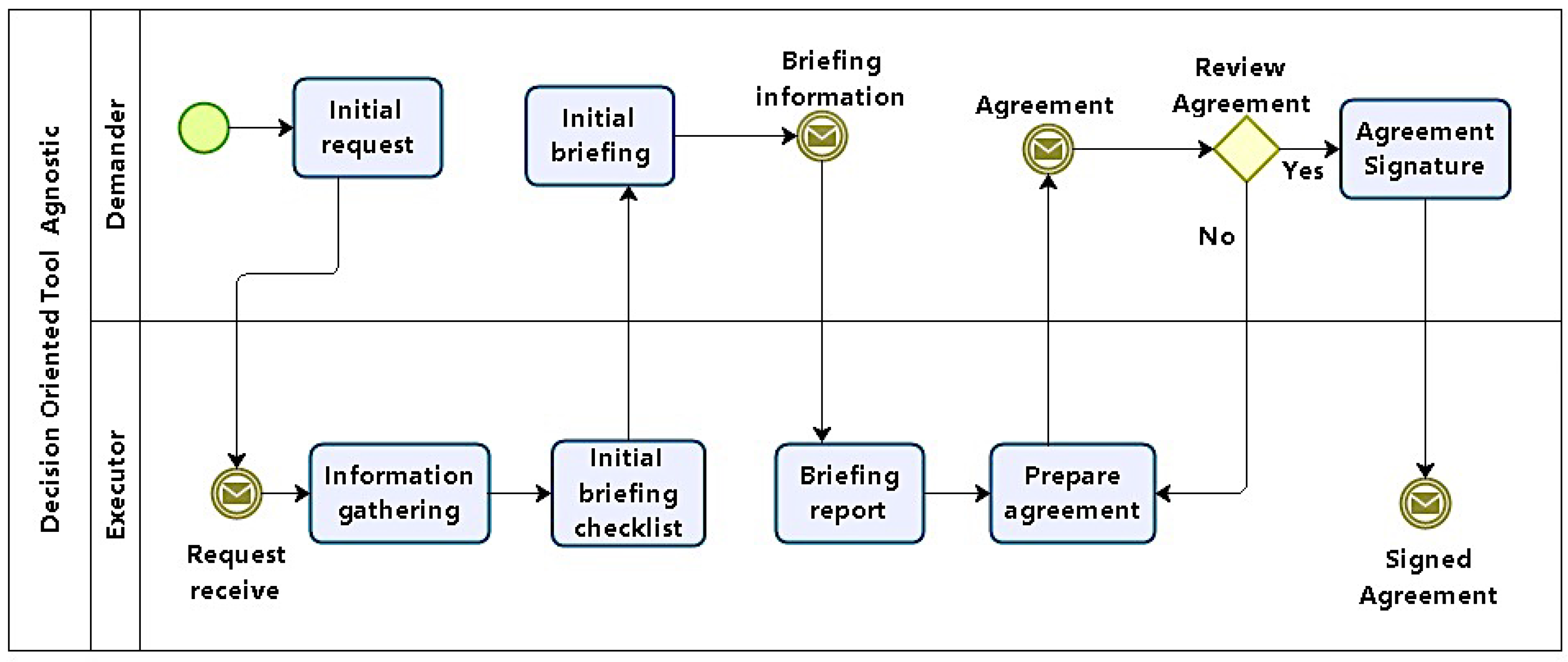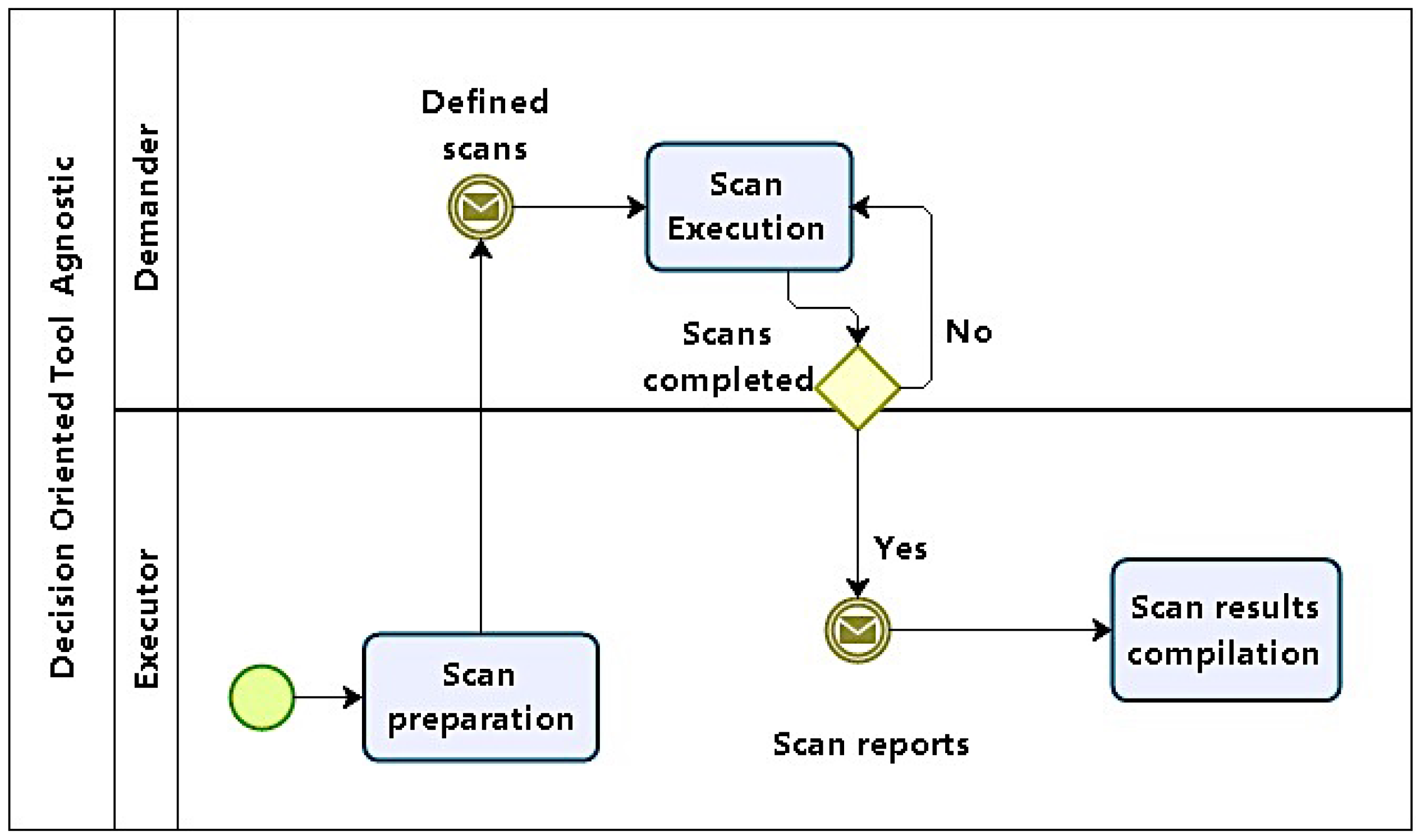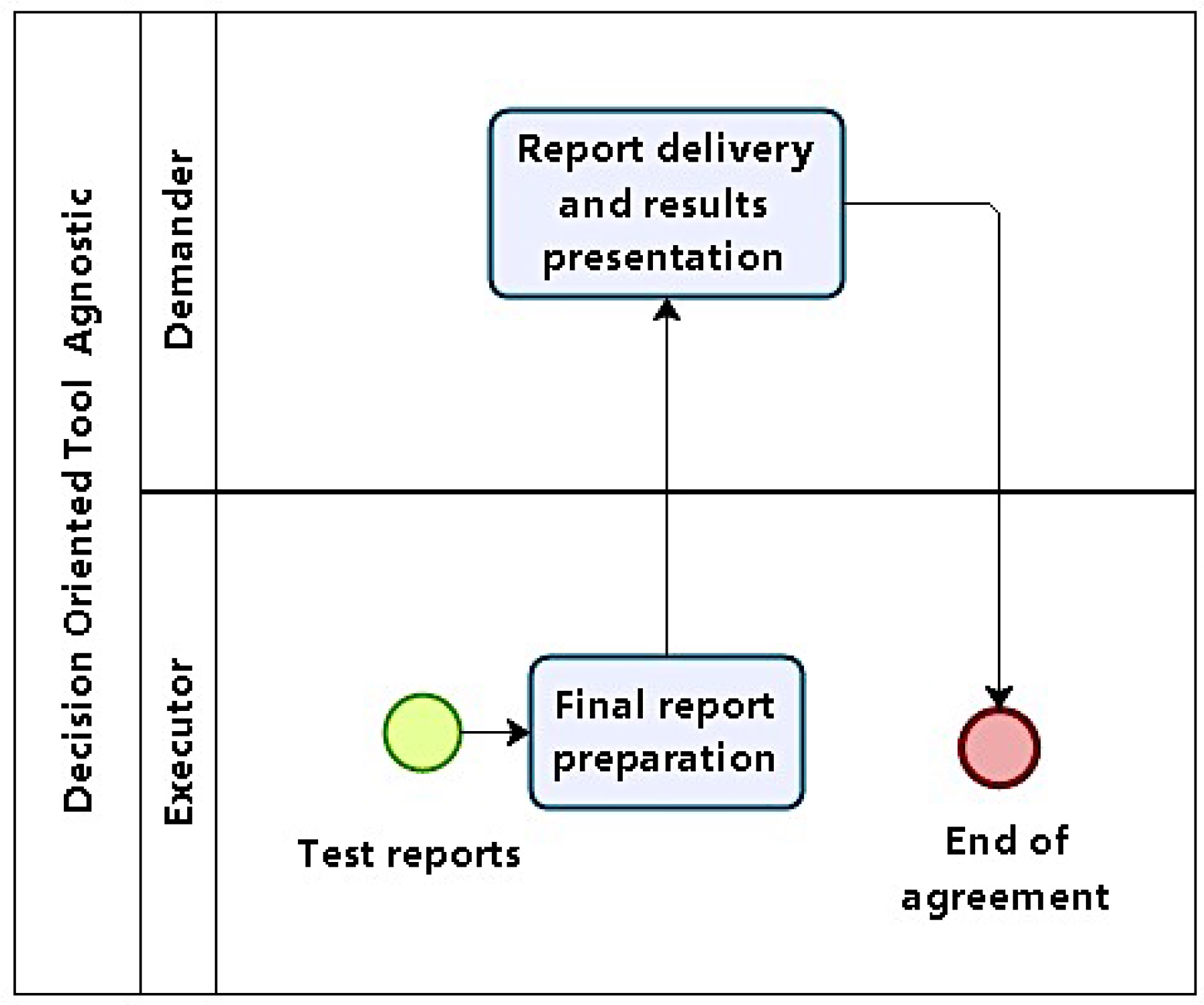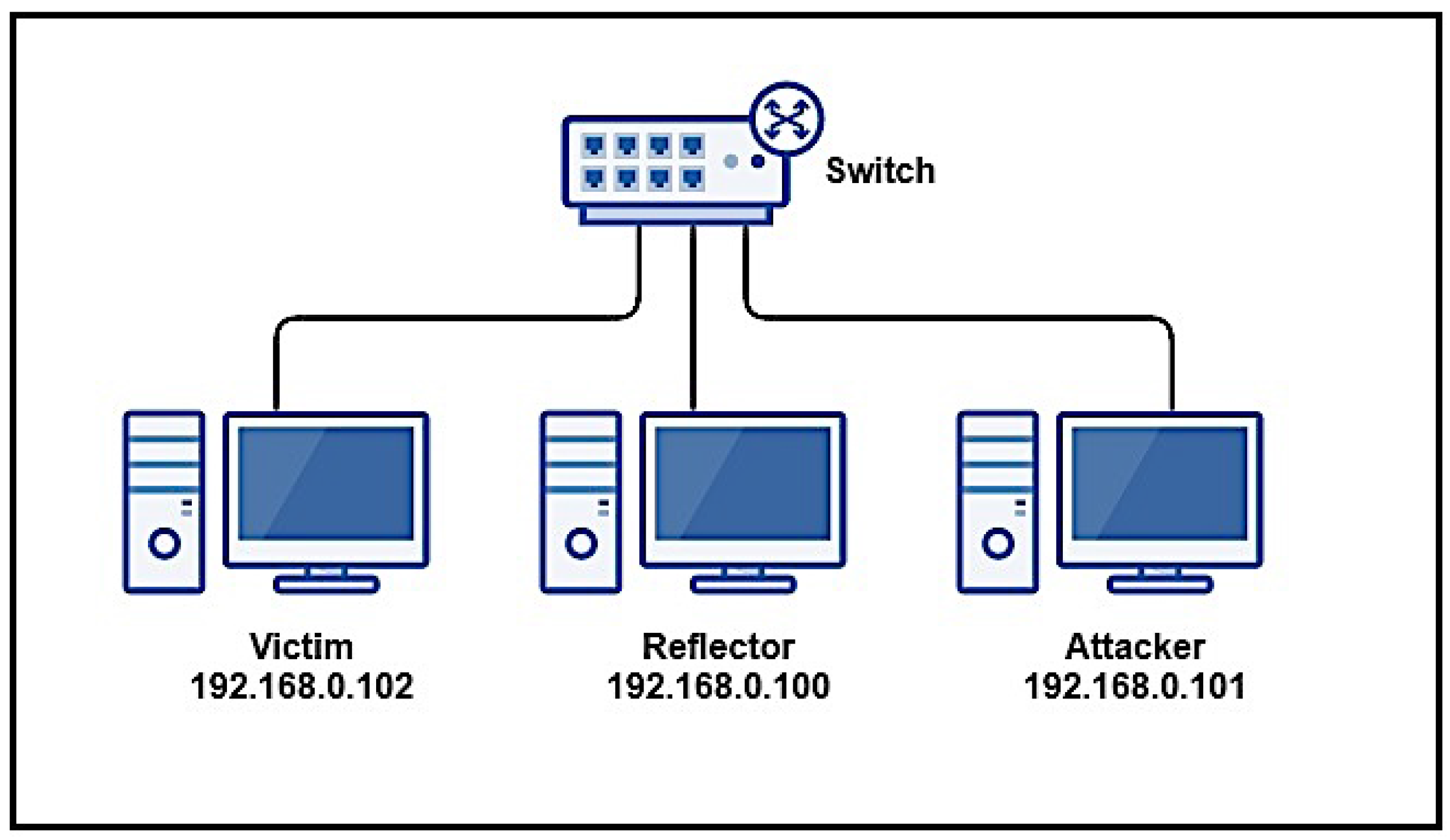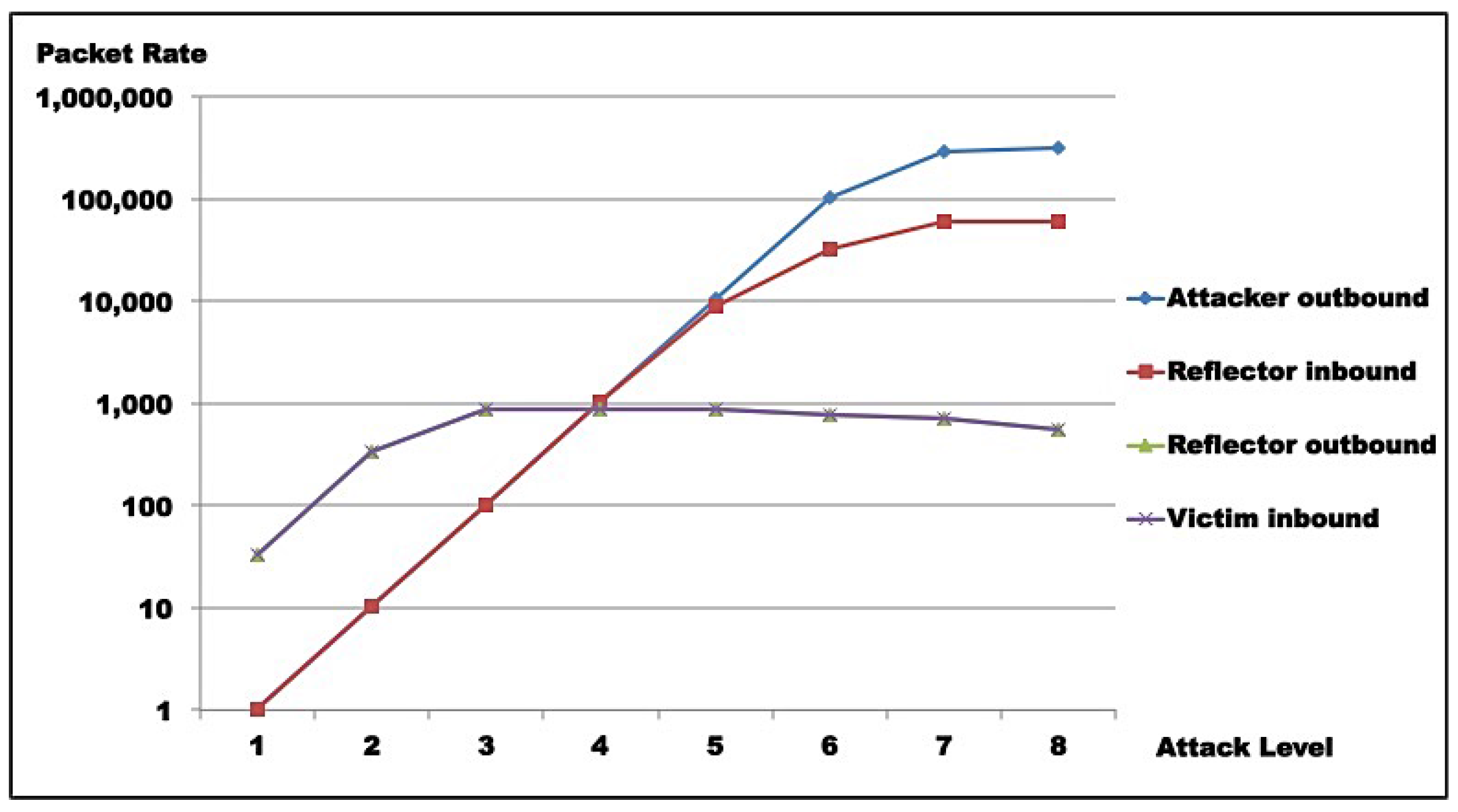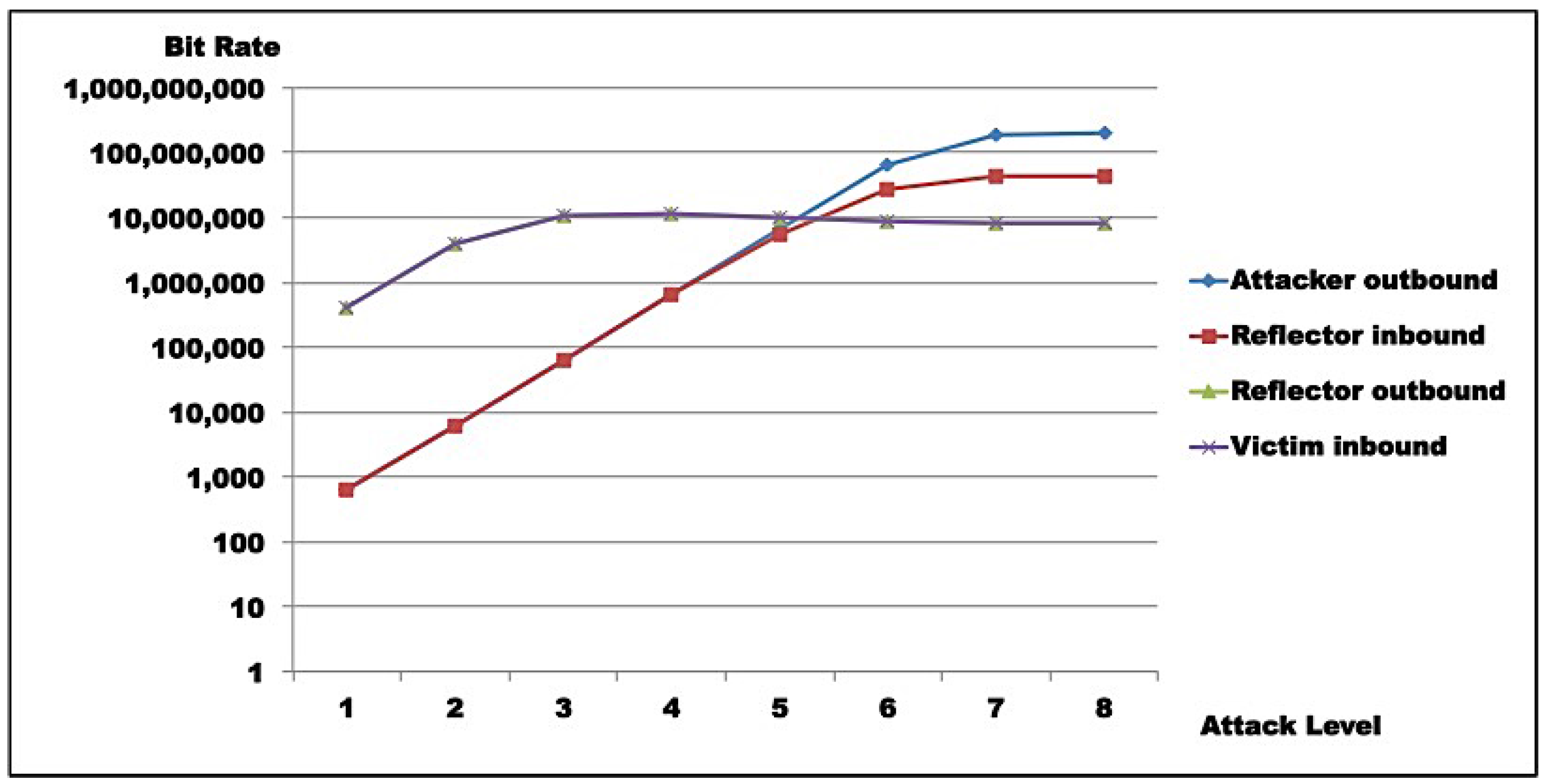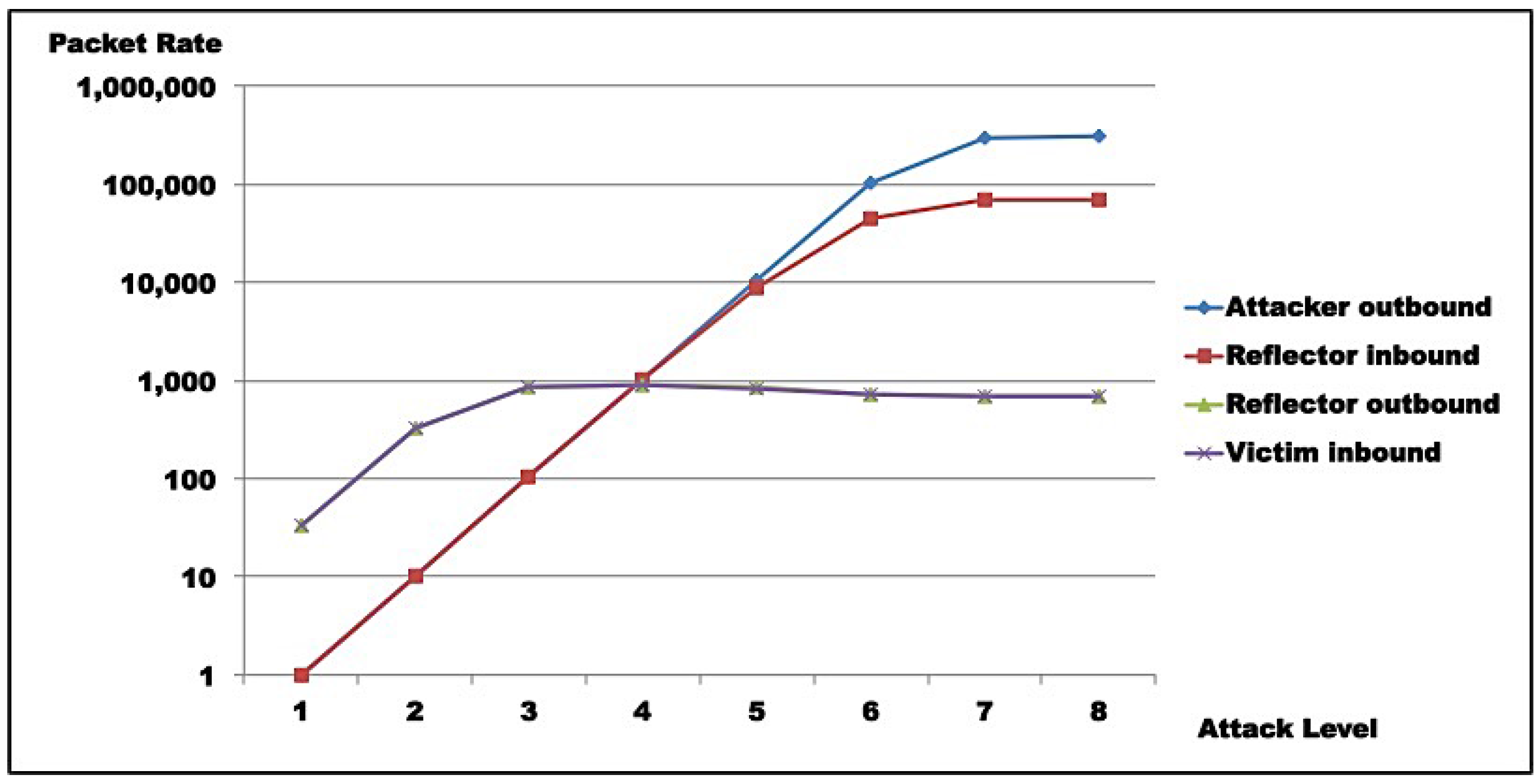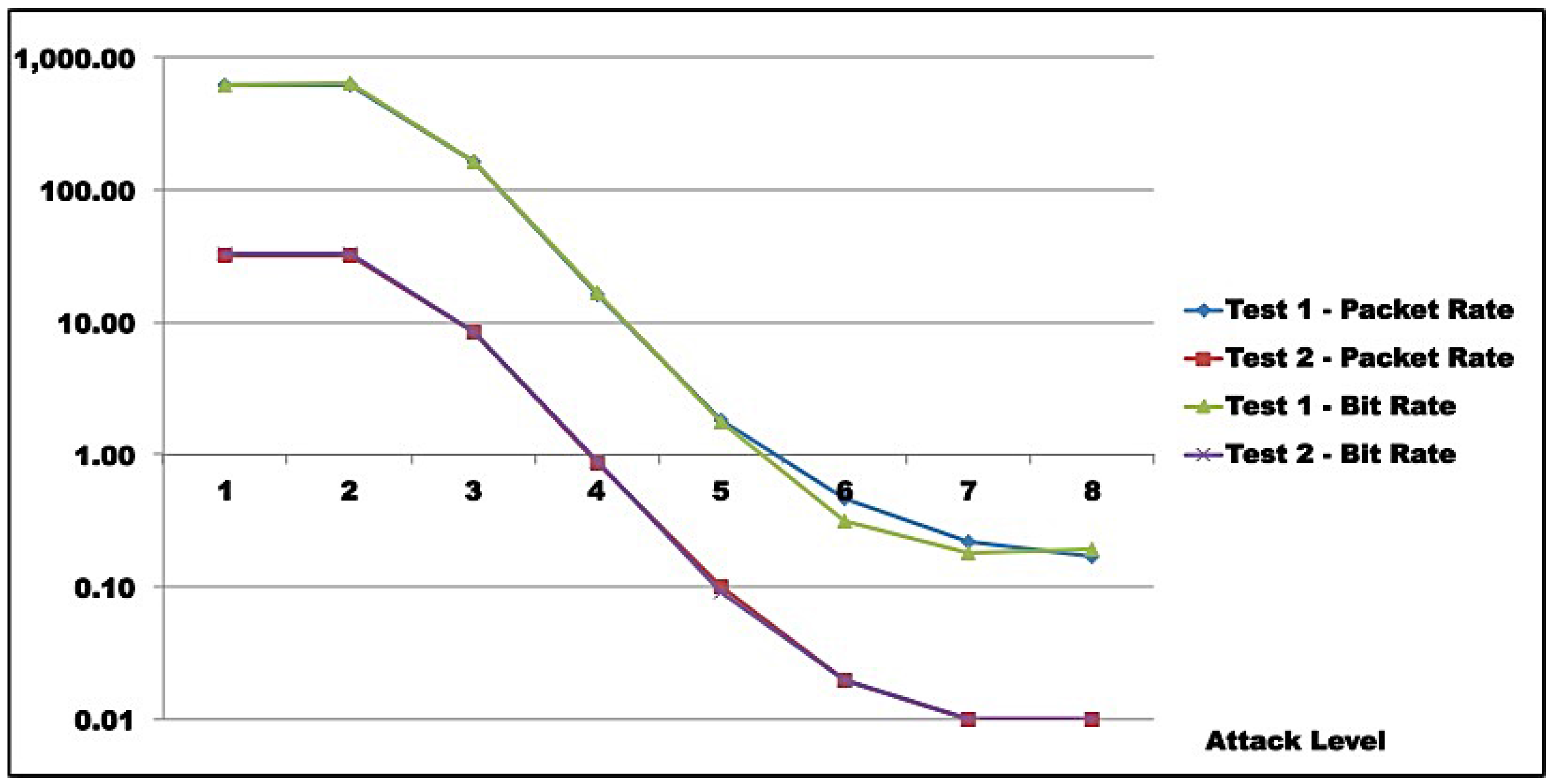1. Introduction
The exponential growth of the Internet of Things (IoT) and its widespread use in diverse areas has brought along several security issues, covering data privacy and integrity, access control, and availability, just to name the most common [
1]. Typical IoT devices are, in their majority, limited in computing and communication power, so implementing security becomes an even harder task, as resources are prioritized for functionality rather than security. The general perception is that impact due to security flaws hits harder, either by device functional criticality or because of their huge numbers, or both. One major concern is the abuse of IoT infrastructure in distributed denial of service (DDoS) attacks, either to attack other infrastructures [
2] or to be targeted [
3,
4]. There are several reports of both sorts of incidents on the Internet [
5,
6]. However, threats are assessed based more on inference than on factual evidence. Usually, the methods for assessing availability threats are close to stress tests. However similar in its effects, denial of service (DoS) attacks differ substantially from stress tests. The main difference is that attacks are deliberately caused by an attacker. This completelychanges the form in which DoS attack impacts are to be estimated.
In certain ways, the picture resembles what happened with universal Internet access. Then, the dissemination and use of Internet technologies brought about a dilemma: on the one hand, these technologies offer services and informational resources at low cost, such that resulting benefits cannot be ignored; on the other hand, they were not conceived with security concerns, leading to incidents involving systems compromise and information breaches.
Even before the last expansion boom in the early 1990s, security incidents in the Internet were frequent [
7,
8]. As the Internet grew, offering more applications (mainly e-commerce and e-government), security concerns escalated. Organizations could not refrain from using the Internet. However, they were afraid their systems could be invaded, tampered with, or attacked. Many organizations understood that an efficient form of testing and assessing risks and threats to their systems and information was to apply–under controlled conditions–the same techniques, procedures, and tools used by attackers to evaluate their systems’ level of insecurity.
There are several ways to assess the security of information systems, such as network scans used to map network topology and services, or vulnerability scans where tests could identify them. Typically, those procedures are tool-based and produce lists identifying systems and nodes, enumerating their vulnerabilities. An important difference between those procedures and Active Vulnerability Assessment (AVA) is that the latter includes penetration tests (pentests) in its repertoire. Thus, its focus is not restricted to identification and (possibly) correction recommendations, but a more thorough and precise picture. When properly conducted, it may demonstrate the impact and relative importance of vulnerabilities with respect to the organizational environment under examination.
Summarizing, AVA focuses on providing a clear vision of what finding a vulnerability during a pentest means when confronted with the organizational information security context. Those were the main motivations and concerns that led to the development of a Decision-Oriented Tool-Agnostic (DOTA) methodology for performing AVAs. DOTA emphasizes repeatability and on modeling information and decision flows along the process, regardless of tools and procedures adopted. In this last aspect, it differentiates from other methodologies, being self-contained and general, yet useful.
Back on the IoT side, the motivation is to use DOTA to test availability threats, like DDoS attacks. The objective is to assess a specific form of DDoS attack when targeting IoT devices and infrastructure. Amplified reflection DDoS (AR-DDoS) is behind most significant high bandwidth incidents from 2013 on. IoT infrastructure seems to be a good target, as it offers a large number of devices with limited capabilities and few security features. The assessment is carried out in a methodical manner using DOTA. Results obtained show that concerns about AR-DDoS are founded, but it is more likely that IoT infrastructure and devices will be hit as much as final victims.
In general terms, the main contributions presented here fall with in two categories:
Methodological: A conceptual gap present in current pentest methodologies, concerning decisional aspects in pentests is address ed and filled; DOTA–a decision-oriented tool-agnostic methodology for AVA–is presented, along with its testing and on-field real-word scenario validations and a general, tool independent, yet applicable and useful attack execution model for tests (here understood as consented and controlled cybernetic attacks) is presented.
IoT Security: The quantitative and qualitative description of amplified reflection distributed denial of service (AR-DDoS) attacks abusing IoT infrastructure and devices, and the empirical evaluation of threat surface scope and impacts.
This article is organized as follows.
Section 2 presents related work, with the state of the art in terms of DDoS attacks on IoT, pentest methodologies, and the conceptual tools used in DOTA, while
Section 3 describes the problem situation addressed. In
Section 4, the methodological approach used in DOTA modeling is described; validation test rounds, along with their results, are reported.
Section 5 discusses AR-DDoS attacks abusing IoT infrastructure and devices, where tests are executed and described along with their results. In
Section 6, conclusions and further work close this paper.
3. Problem Description
Security is a deep concern in the context of computer networks and IoT, with the discussion focused on privacy, integrity, access control, availability, and resilience. With respect to availability, DDoS attacks are top of the list, either targeting IoT infrastructure and devices or abusing them to reach third parties. The consensus in the security community is that DDoS is a serious threat, and there are proposals to deal with it. However, apart from inference, qualitative and quantitative assessment of possible threat impact to IoT is needed to properly deal with them.
The usual way availability is assessed does not explicitly account for attack conditions. Therefore, if tests are to assess attack impacts, they have to include the attacker’s point of view for a more precise evaluation. This is the motivation for a methodology for vulnerability assessment which not only identifies but actively tries to exploit vulnerabilities. As reviewed in
Section 2, there are several methodologies that define and guide the process of actively assessing vulnerabilities. However, despite defining processes and activities, they focus on operational aspects, and base their actions on sets of tools. The use of tools is not a problem in itself, but may reduce the scope and applicability of a methodology.
The security scenario is extremely dynamic, and a methodology coupled to a set of tools generates one of three situations: threats evolve, and new tools (along with procedures) have to be included in the methodology; defensive measures evolve, and tools either become less efficient or have to be updated, and hence the methodology too; systems evolve, and tools become obsolete, and then the need to evolve exists as in the previous cases. That is, tool obsolescence leads to methodology obsolescence. Thus, tool-based methodologies either have short life cycles or have to evolve continuously. In order to avoid this situation, a methodology should be tool-independent, or agnostic: instead of having its activities defined by the tools adopted, it should provide the means of defining the tools to be used in the process. The methodology then should focus on the rationale which defines actions (i.e., decisions), and should provide guidelines on what needs to be considered to decide the course of action during attack execution.
Before getting to attack execution, a series of preparatory actions is necessary: the high-level definition of what should be tested, and under which conditions; the basic information gathering about systems to be tested; attack planning from strategic to executive levels. After testing comes the reporting and presentation of results, and during the whole process, the systematic generation of records.
Those are the principles that guided the development of a decision-oriented, tool-agnostic methodology (DOTA) for AVA. DOTA formulation is intended to cover vulnerabilities in general, but is also expected to be flexible enough to accommodate not only DoS attacks, but other forms of vulnerabilities.
The IoT, along with sensor services and devices, are in the offered attack surface, and are exposed to availability threats, like denial of service (DoS) attacks. DoS attacks aim at exhausting device or infrastructure resources in order to cause service disruption, and hence its unavailability. In its volumetric form, attacks basically consist of sending a large number of requests that either overwhelm services when attempting to process them, or exceed traffic limits [
41]. One common form of implementing and potentializing DoS attacks is using distribution (distributed DoS, DDoS), in which several nodes send traffic in a coordinated way, resulting in higher attack efficiency and more complex mitigation given source obfuscation.
There are several forms of DoS attacks, which can be organized in two major classes: volumetric attacks, and protocol abuse. The latter covers low volume, slow rate attacks where legitimate traffic probes exploiting specific protocol features, characteristics, or implementation details lead to an exhaustion of some of the victim’s resources, and consequently, legitimate requests are not properly responded to. The first class, on the other hand, includes attacks where large traffic volumes flood the victim, exceeding its processing capacity or link bandwidth, so that legitimate requests are not treated.
DoS attacks by protocol abuse can be broken down into protocol exploitation, when the attacker maliciously uses some feature or characteristic; and in implementation exploitation. As an example of the first modality, there is the
Slowlorris attack, where HyperText Transfer Protocol (HTTP) GET messages are sent without completing the requested resource address, and
RUDY, where slow rate single character HTTP POSTs are sent [
42]; whereas for the second, the classical
Ping of Death attack with oversized Internet Control Message Protocol (ICMP) datagrams is an instance [
43].
As for volumetric attacks, they can also be divided into flooding attacks and amplified reflection attacks. Both forms try to overload some victim resource (usually bandwidth) by sending large traffic volumes to the victim. In flooding attacks, compromised nodes send traffic straight to the victim; while in reflection attacks, intermediate nodes–reflectors –are used to flood the victim. For the purposes of the attacker, a reflector is any node that sends an IP datagram in response to one previously received. For AR-DDoS, reflectors of interest are those that amplify; i.e., their response produces more bytes or packets, or both, than the original input datagram. This behavior is characterized by a reflection factor, indicating how much traffic is generated by the reflector. So, amplifying reflectors potentialize traffic generated by an attacker [
44].
A final ingredient common to most DoS attacks, including AR-DDoS, is
IP spoofing, which consists of crafting arbitrary source addresses in IP datagrams. In DoS attacks, attackers use this technique to obfuscate the real attack source. Characteristically, in AR-DDoS, attackers send traffic to reflectors using the victim’s address as source address [
45]. The protocols most commonly abused in AR-DDoS are Domain Name Service (DNS), Network Time Protocol (NTP), Simple Network Management Protocol (SNMP), and Simple Service Discovery Protocol (SSDP). They are challenge–response, and provide significant amplification in their response [
46].
3.1. Research Design and Description
As already presented, the consensus in the security community is that DDoS attacks pose a real threat to IoT, with its devices serving either as direct target, or for abuse in order to hit some third party.
The main purpose of this work is to assess the threat to IoT represented by AR-DDoS attacks. AR-DDoS is chosen among other forms of DDoS for its relatively low complexity and attacker effort, large availability of potential reflectors, and high efficiency. In order to fully and properly assess this threat with respect to IoT environments, it is necessary to assess impacts on reflectors and attackers, and the roles IoT devices could play in the event of an AR-DDoS attack.
The main hypothesis to be verified is related to reflector behavior, in terms of saturation. This point is crucial in assessing potential IoT abuse, since its devices would primarily be reflectors in an attack of that kind. Specifically, IoT devices’ saturation behavior when used as reflectors is to be determined. Note also that saturation may occur either as bandwidth exhaustion or excessive processing load.
Methodologically, he first option considered to characterize that sort of behavior is via network simulation. However, results would be restricted to saturation due to bandwidth exhaustion. So, simulation was not chosen.
A second option was to assess saturation behavior using stress test techniques, but that was also considered inadequate. The main reason is that those tests–however efficient in determining capacity–do not include the attacker perspective in their model; that is, the influence of a motivated entity that decides the course of actions during an attack to deliberately cause service disruption.
Implementing and running an instance of an attack (in this case, AR-DDoS) in a controlled environment was an option to be considered. With this approach, not only reflector, but also complete attack behavior could be studied. Although the idea is not completely new, this particular application is novel in the context of IoT, and could motivate interesting research questions. For example, if indeed saturation occurs, how does it influence attack efficiency; or, given overall attack behavior, how this information can be used to enhance mitigation and prevention strategies.
As a first question, there was the need to choose a particular instance of the attack. That instance should represent a realistic threat to IoT devices (see discussion in
Section 5.1). There was also the requirement of fully dominating the attack cycle.
The question of choosing the attack and developing operational capabilities to perform it led to the need for a methodology–not only to guide that choice, but the whole process of planning, implementing, and executing the attack. Literature review demonstrated that there were well-established practices, but they were mostly constructed around a set of tools. As pointed out previously in
Section 2.2, pentest methodologies dependent on tool sets had life cycle restrictions which might invalidate long term results.
Then, research took the path of developing a pentest methodology focusing on the decisions to guide the process. It was validated in its building blocks, and then in full rounds in different scenarios. In the sequel, this methodology was adapted to focus on availability, and later used to address the main questions of interest in this work.
The methodology guided the choice of protocol used in AR-DDoS, attack planning, implementation, and execution, which later supported result analysis and presentation.
4. DOTA Methodology
DOTA Methodology consists of six phases, which are executed in a sequence, each phase grouping processes and activities. For the purposes of modeling, two entities were considered: a demander and an executor. The model was produced using Business Process Modeling Notation (BPMN) [
47], supported by
BizAgi Process Modeler [
48], criteriously observing the execution of each phase, which are described in the following.
4.1. Methodology Description
DOTA is sequential, in the sense that products of one phase are used as input for the next. DOTA phases are described and detailed bellow. For the purposes of modeling, there are two entities in the whole process: the demander and the executor. As presented in
Section 2.2, current methodologies are recognized market practices, and in some cases, standards, so that DOTA follows their formatting.
4.1.1. Phase 1: Task Specification
In phase 1, the task to be executed is specified. According to the process model in
Figure 2, this first phase defines the conditions under which pentests will be carried out, organizing test models, scope, focus, restrictions, and constraints. It should also define how results will be treated, and to whom they will be presented. Its main products are artifacts which consolidate this agreement, including formal consent from the demanding organization.
In this phase, representatives of both demanding and executor entities will together define the focus and scope of tests. Emphasis should not be on the technical aspects involving tests, but on the strategic business importance of systems to be tested with respect to the organization. It is desirable that specific complaints concerning specific systems be reported.
Initially, a request for an AVA is placed by the demander and passed to the executor. Minimally, the demand includes a high-level definition task and main target (organization, network, host, etc.). The executor then gathers information in order to produce a checklist with questions and decisions concerning tests, which will guide the initial briefing.
The initial briefing is the moment when demander and executor answer the checklist to generate a report. The last activities in this phase involve preparing and signing an agreement between demander and executor. Although that might be unnecessary when demander and solicitor are the same, in the general case, some legal framework is needed to protect both parts.
At the end of this phase, the following questions should be answered:
Are tests to be executed external or internal to the demanding organization?
Which security property should be prioritized in tests?
Are there any hosts, servers, or specific addresses to be tested?
Is there any service–critical or not–to be tested?
Is there any application–critical or not–to be tested?
Is there any information that should be assessed in terms of confidentiality, integrity, or access control?
Is availability to be tested?
It is acceptable if tests cause denial of service?
Are tests to be executed furtively and stealthily?
What is the basic timetable, including test periods and final report presentation?
What are the costs and resources involved?
Answers to all questions should be mandatory. However, questions 4 to 6 may be left open, since they depend on the demanding organization’s security awareness and maturity.
4.1.2. Phase 2: Initial Scans
Phase 2 starts with initial scans that will lead to the analysis of information systems and computational structures in the environment under exam in order to identify vulnerabilities (
Figure 3).
Scans should be carried out in increasing levels of: depth, intrusiveness, and detail. Then, scans should start with: network sweeps to map topology and infrastructure, including not only server, but devices like firewalls and other security appliances; service scans to identify services and the software that implements them, along with their versions; and vulnerability scans targeted primarily at applications; it also should be fine tuned to cover the identified service software versions.
With information obtained in Phase 1, scans are planned and prepared. The first step is to define what will be scanned, given scope information from the initial briefing report. Execution sequence, not only in terms of networks, hosts, services, and applications (if any) to scanned, but also of the information to be obtained. Another point to be considered is whether tests are required to be performed stealthily, in order to avoid detection.
First, scans start identifying network structure and topology, then moving on to hosts. At host level, relevant information is associated with operating systems (OS) fingerprinting and service, along with server software identification. The next level focuses on finding vulnerabilities using the system and service inventory produced by previous scans. Finally, if the test scope includes applications, they are scanned.
It should be also noted that in cases such as web applications, even with available tools for scans, manual techniques involving code inspection could be necessary.
4.1.3. Phase 3: Target Selection
After running different scan levels, information regarding topology, services, applications, and vulnerabilities is available, and targets can be selected, using them as a basis for choice. Hosts with vulnerabilities identified in phase 2 are considered potential targets. Phase 3 (as in
Figure 4) planning starts with target selection, using previous results, which are grouped and analysed. The first step is to classify and order vulnerabilities with respect to their severity, ease of exploitation, and relevance with respect to the objectives defined in phase 1.
Concerning the criteria used in classifying and prioritizing vulnerabilities, severity relates to the scope of a system’s compromising. For example, a system victim of unauthorized access which allowed restricted access to non critical resources should be ranked with low severity, but if access was granted to important or critical global resources, then the severity score should be high.
For relevance, assessment takes into account the compromised system’s functionality relative to test objectives. So, compromised hosts which do not provide services related to objectives are ranked low, whereas systems hosting relevant data are to be ranked high.
Ease of exploration relates to necessary executor skill and tool support. For example, vulnerabilities whose exploitation is supported by tools which require simple command execution are ranked high, but if there are no tools, and execution demands a series of complex procedures and involves decisions, then rank should be low.
Possible targets are consolidated in a list ordered according to the vulnerability rank, followed by relevance and ease of execution.
4.1.4. Phase 4: Tactical Definitions
Phase 4 (
Figure 5) involves decisions concerning tactical definitions. With the prospective target list, exploitation methods are defined taking into account expected results and impact. Targets are also prioritized, not only in terms of importance, but also in terms of possible attack sequence, in order to have a feasible path of execution. These definitions are the basis for attack plans, which are the main artifact produced in this phase. If needed, plans may be revisited in the future in case tests do not achieve objectives.
The first step in this phase is to perform a thorough target analysis, in order to produce test plans. This contrasts with phase 3, when targets were analyzed with respect to their possible impact. Tool support is revisited to detail their availability, effectiveness, and stealthiness. Another aspect to consider is target complexity when tool support for vulnerabilities identified is inadequate or non-existent. It might be the case that some specific high-value target needs specific tools which would need to be developed, and the effort required has to be estimated.
There is also the case of emerging targets. They are low-ranked targets whose compromising in some way would facilitate the exploitation of a high-value target. Despite being non-obvious targets, their inclusion may simplify planning and reduce overall effort.
After targets are chosen and ordered, executive test (attack) plans are elaborated. Plans should include: objectives, targets (hosts and vulnerabilities involved), techniques to be used, tools (along with their configurations), and the sequence of actions with their expected results and decisions concerning the course of events.
Closing this phase, in preparation for the next, tools are prepared, including: procurement, development, installation, configuration, testing, and training (if needed), along with plan revision.
4.1.5. Phase 5: Test Execution
After defining each attack plan comes their execution, which will test for found vulnerabilities. DOTA models attack execution without going into the specifics of procedures, techniques, or tools, using modified OODA cycles. Thus, attack execution is modeled by
Observe–Analyze–Decide–Act (OADA) cycles, which take advantage of certain cyber attack dynamic properties, and simplify original OODA cycles. It is in phase 5 that tests are executed, as in
Figure 6.
Tests are executed as a trial and error process, where specific stimuli produce responses which may be as expected or not, having in mind that: the executor does not control targets, and scans may have produced false positive and false negative results in previous phases. By observing responses, it can be inferred whether tests were successful or not, motivating further action so that stimuli are changed to produce new responses. These on the fly adjustments tend to make revisiting phases 3 and 4 unnecessary.
Then, test plans for exploiting vulnerabilities in prioritized targets were generated. Now, plans are to be executed, and changes are included when needed as part of the expected modus operandi. As each plan is interactively carried out, test execution was modeled in cycles which adapt actions according to results obtained.
Execution cycles include four steps, as as described below:
Observation: Checking if test pre-conditions are present; when the cycle runs, the previous step post-conditions will be examined here.
Analysis: Conditions are assessed; if they are the result of some previous action, its effectiveness is evaluated, and possible corrective actions are suggested towards achieving objectives.
Decision: Given the results from previous analysis and possible actions, a choice for the next action is made.
Action Implementation: the action chosen is executed; when completed, return to observation.
Test cycles should be executed until one of the options below takes place: the objective is achieved; time runs out; or the test is aborted for some reason, such as improper planning.
4.1.6. Phase 6: Reporting
When test cycles have finished, logs and results are compiled. They will serve as a basis for reports. In phase 6, results are consolidated and presented. All previous reports, logs, and plans produced as artifacts in previous phases are grouped to produce a final report (
Figure 7).
4.2. Results and Analysis
DOTA was developed based on practitioners, expert and industry experience. So, despite its prescriptive character, it also describes best practices. One of its goals was to produce an applicable methodology capable of generating useful results close to existing security culture.
In order to validate DOTA, the initial approach was to test isolated phases. These tests were executed in controlled environments, and led to full runs involving all phases which consolidated a first version. The next step was to test DOTA in real-world scenarios. Those tests are reported in the following.
4.2.1. Test Scenario 1: Internal Infrastructure and Applications Test
The scenario for the first set of tests was a full methodology run as part of a risk assessment process executed in a medium-size organization. DOTA was run to identify and assess risks associated with the technological environment.
The summary of conditions defined in Phase 1 is presented bellow:
The objective was to generate a panoramic view of the state of network and application security;
There was no specific security complaint;
The test was to be executed locally, with internal access to the network, initially without and then with user credentials;
Scope included connectivity and network infrastructure, basic services (DNS, Simple Mail Transfer Protocol (SMTP), HTTP, etc.), and web applications;
Tests should focus on confidentiality and integrity, as availability was out of scope;
Two member team;
Two weeks to test and produce report.
Under those conditions, scans were executed (Phase 2) sequentially on networks, services, and applications. During service scans, denial of service occurred repeatedly, leading to abortion of the procedure. As a consequence, scope was repactuated to exclude services.
With results from scans, targets were chosen among network devices and applications, as servers were now out of range. Network devices were prioritized, taking into account their criticality, whereas the criterion for applications was their importance and alignment with the organization’s mission. The following test plans and sequencing were defined (Phase 4). Tests were then executed (Phase 5). Results obtained were:
All fifteen network devices, including core devices, were compromised with privilege access;
All six web applications were compromised with several vulnerabilities (total of seventeen), including Structured Query Language (SQL) injection and Cross-Site Scripting (XSS), among others;
Application data could be accessed and modified.
The final report was generated in about one third of the total available time. The systematic recording in previous phases–as prescribed by DOTA–had a positive impact, as reported by experts and practitioners.
The execution of a full methodology run in a production environment demonstrated that it could generate valid results in a reasonable amount of time. After presentation (Phase 6), the demanding organization was satisfied with results. The exclusion of server tests due to denial of service was also understood as a valid result (however unexpected), and indicated the need for an infrastructure upgrade.
Table 2 summarizes the results in numbers.
4.2.2. Test Scenario 2: External Web Application Test
The second test scenario also performed a full run of the methodology. The objective was now to assess the security of an HTTP server, along with its web applications. The methodology was executed as an independent process to identify and assess risks associated with the web site and its applications. Since the system under examination was in production, and the demanding organization did not accept service interruption during tests, the whole system was cloned in a mirror host, where tests were effectively carried out.
The execution conditions for this second test were:
The objective was to assess server and application security;
There were specific complaints regarding web site security;
The test was to be executed externally to the network under exam, without user credentials;
Scope ranged over HTTP server and web applications, both server and client side;
Availability was out of range, and service outages were not allowed;
Focus on confidentiality and integrity;
Tests need not be executed furtively or stealthily, as the demanding organization’s IT team knew about them;
Two member team;
Four weeks to present final report.
With conditions defined (Phase 1), scans were executed–first services, then applications (Phase 2), identifying vulnerabilities. As the target was already defined, vulnerabilities to be tested were chosen from scan results (Phase 3). Vulnerabilities were prioritized according to criticality in service and application, considering their relative importance and alignment with regard to the organization’s mission (Phase 4).
After test execution (Phase 5), results were:
Server operating system and service software was outdated with several critical vulnerabilities;
Web application was compromised with several OWASP Top 10 vulnerabilities, some with more than one instance;
All web application software components used (five) had critical vulnerabilities.
The final report was elaborated in about one-fifth of the available time (Phase 6), due to previous phases systematic artifact generation, as prescribed by DOTA.
The full run on a replicated production environment left testers free to test without worries about service interruption. Again, valid relevant results were obtained in reasonable time, and the demanding organization considered the results very satisfactory. Results are summarized in
Table 3.
4.2.3. Test Scenario 3: Comparative Test
The third scenario was the most complex, and had the purpose of providing a basis for comparing DOTA as a methodological approach as well as a methodology itself with other approaches and methodologies seen in the information security market. Another objective was to consolidate test execution modeling with OADA cycles. This test consisted of a full methodology run simultaneously with other methodologies.
The test scenario was formatted as a competition. Five teams were formed, each with five members. Teams were leveled given their relatively little exposure to pentest techniques and tools. Each team was free to adopt any methodological approach, except for one that would necessarily use DOTA.
Tests were not executed in a real production environment, but on a simulated network, each team working on an instance of it. The test was exploratory: teams received only an initial IP address, and the general task of identifying hosts, discovering vulnerabilities, and exploiting them.
Competition rules were:
Teams were not supposed to exchange of information;
Each team had access to an instance of the simulated environment, with the same topology, configuration, and vulnerabilities, giving them equal conditions;
Teams did not know the environment beforehand; they only had the entry point IP address;
Hosts in the simulated network ran distinct operating systems with distinct vulnerabilities;
For each host identified, each team had to execute three different tasks involving vulnerability exploitation (e.g., intrusion, privilege escalation, system file modification, etc.);
Each team had five access slots to its simulation instance, each four hours long with a 48 h interval between accesses, according to a timetable;
After the last slot, each team had 48 h to present a report with their methods, procedures, actions, and findings;
The team with the highest score (weighting tasks executed and report) was to be declared the winner.
The 48 h interval between accesses was motivated by limitations on available resources. However, this interval, along with the limited time slot, emphasized the need for careful action planning and optimized decisions. It must be noted that evaluating whether DOTA favored those aspects was also an objective.
All five teams followed the planned access timetable, worked according to the rules, and delivered their reports on time.
Table 4 synthesizes results obtained by each team.
Figure 8 and
Figure 9 detail them.
Results clearly show that Team A (which used DOTA) produced results superior to those obtained by other teams, either quantitatively, by the number of targets explored and tasks executed, or qualitatively, by the form in which the whole exercise was carried out. In debriefing after tests, Team A members reported that they used the first slot only for recognizance, finding only the host with the initial address, over which they ran scans and found vulnerabilities. Then, they took advantage of the 48 h interval to plan activities for the next slot, when they managed to take over the host and find the target network. In fact, they identified not only the target network, but also the simulator management and control networks. Other teams also found those networks. However, by following DOTA, Team A kept their options open, performing wide scope scans, and found vulnerabilities in the management software that gave them the chance to completely control their simulation instance, including details of simulated host parameters. Team A then took advantage of this information and defined the sequence of host compromising and respective executive plans. Successfully, actions were performed following OADA cycles, either in test execution or in evaluating their results.
4.3. Synthesis
The methodology presented here was submitted to test rounds that demonstrate that its application contributes to broader, deeper, and more precise results.
During the third test, referees had to repeat tests, and the only team to have all their results confirmed was the winning one. So, the use of DOTA also contributed to the reproducibility of the results. Besides, the use of OADA cycles evidences the gains in breaking down and making explicit the decision process, not only in preparatory phases, but also in test execution.
It should be noted that between the second and third tests, there was an opportunity to evaluate DOTA flexibility. It involved security auditing a system prior to its deployment in production. The main difference in terms of applying the methodology was in Phase 2, where all system documentation was available. The effect of that difference was that, given the larger amount of relevant information about the system to be tested before test planning and execution, results were amplified; i.e., results were broader and deeper than those obtained under normal methodology application conditions.
Although it was not an original design objective (but is certainly desirable), results show that DOTA is also flexible when applied in scenarios diverse from those envisaged in its design.
Table 5 shows a comparison of general scope methodologies and DOTA (OWASP was included, despite being specific to web applications, given its relevance).
Thus, even taking into account that the volume of tests is relatively small, results corroborate that DOTA application achieves objectives like repeatability, decision explicitation, and flexibility in application.
6. Discussion, Implication, and Conclusions
6.1. Discussion
Test results indicate that saturation was achieved at reflector and attacker levels. In both test rounds,
Figure 11,
Figure 12,
Figure 13 and
Figure 14 indicate the reasons for saturation. For the attacker, saturation occurs when line speed is achieved. For the reflector, line speed is not achieved, and probe processing for amplification requires more processing than probe generation. So, reflector saturation is due to processing.
Results also demonstrated AR-DDoS is feasible, and can achieve high amplification rates. However, high amplification rates are not sustainable, even for reflectors with relevant computing power, as reflector saturation takes place at relatively low inbound rates. So, if attacks are not carefully conducted, the abused reflector infrastructure saturates, and victim DoS is not achieved. As a consequence, the attack would hit the reflector harder than the victim. Even so, a victim could be taken down if several reflectors coordinate their traffic. From the attacker point of view, that can be compensated by lower injection rates and more reflectors, which require more knowledge about reflector infrastructure and better attack execution management.
From the point of view of IoT and sensor networks, it has been argued that they offer expanded attack surfaces, specifically for the sort of attack described in this paper. From test results, it is clear that although the claim is realistic, the results of an attempt to abuse IoT and sensor network devices in AR-DDoS have a great chance of being confined to its own infrastructure. In any case, it is clear that IoT infrastructure and devices will be severely hit, at least as much as third party victims.
As IoT and sensor network devices and infrastructure are to be abused by reflecting and amplifying traffic, given their relatively modest computational and bandwidth capacity, reflectors will most certainly saturate, without necessarily bringing targets down. The number of reflectors involved for successful attacks will be determined by how much residual contribution each device provides in traffic directed to final victims. As observed, to take advantage of maximum efficiency, an attacker has to inject probes at low rates. By itself, that means less attacker effort, but demands higher skills and much better specific knowledge about the reflector infrastructure to be abused.
Although tests were executed over a specific implementation of AR-DDoS attacks, SNMP was chosen, as it is used in network management in IoT and has a relatively small footprint. The components that led to reflector saturation are present in most protocols candidate for abuse, namely: some computational cost for request processing, and low device computing power. If those are close, saturation will occur. So, it is not far fetched to say that conclusions presented here are fairly generalizable for AR-DDoS based on other protocols.
As a basis for comparison, Solis et al. [
22] evaluates the effect of a DDoS attack over an Wireless Sensor Network (WSN) over Zigbee and 6lowPAN using a network simulation environment. Their results also indicate saturation which occurs at very low probe input rates. However, saturation is present only in terms of achieving network capacity, but there is not characterization of possible saturation due to processing load. Sgouras et al. [
21] also evaluate the impact of DoS/DDoS attacks on smart grids. Saturation is also present. However, devices are not part of the attack as reflectors but victims, which is out of the scope of this work.
These results were obtained by the application of a test methodology that was flexible enough to accommodate availability threat assessment tests. The novel approach contemplates the point of view of an attacker, bringing not only another perspective, but a more complete picture regarding the chosen attack. So, a simple, easy to implement and execute DDoS attack as AR-DDoS is dissected in a series of experiments in order to characterize its traffic dynamics.
6.2. Implication
As presented in
Section 2.1.1, incidents involving IoT devices and infrastructure are already reality, with record-breaking attacks, but amplification is not commonly used. Currently, incidents exploit simple vulnerabilities in device software, so it is more attractive to attackers to re-factor old malware to reach a huge number of new possible victims. It might be argued that efforts to enhance security in IoT should be centered in correcting faults in device software. However, that would not prevent reflection attacks. Note that if the opportunity for botnets reduce, amplification attacks over IoT are likely to become more frequent.
As for AR-DDoS prevention, current best practices are still valid. Specifically in the case of IoT, network segregation, if possible and applicable, and placement behind NAT combined with anti-spoofing filtering are simple yet efficient. However, they demand better network management and configuration control.
6.3. Conclusions
Presented results show that AR-DDoS is a powerful technique that enhances attack capabilities. Despite its overwhelming effects, for an attacker to make the most of it, carefully planned execution is required, contrasting with sheer brute force as in other forms of DDoS.
IoT infrastructure offers a huge attack surface in terms of AR-DDoS that has not yet been widely explored in attacks. By the saturation identified in tests, it is expected that IoT devices when used as reflectors will be hit at least as severely as victims. Fortunately, current best practices for prevention are available, and can be used to mitigate some of the attacks.
In short, the threat is real, but there are ways to deal with it; however, it requires efforts in management and enhancing IoT software.
6.4. Limitations
The main limitation of this work relies on the fact that the approach used is novel, not only in its application to IoT, but for availability in general. The methodology, although mature enough to generate practical useful results, still needs to be applied in different contexts. Despite that, the methodology when used correctly produces verifiable results which are applicable in real environments.
6.5. Future Work
This work is ongoing research which has followups in two directions: methodology, and AR-DDoS in IoT. As pointed out, the methodology used is still evolving. Experiments, not only in the scope of availability threat assessment, but active vulnerability assessment in general, to refine phases and compare with other approaches. As for AR-DDoS in IoT, a comparative study of availability threats represented by other protocols, like SSDP and CoAP, is the natural way to continue this work.

